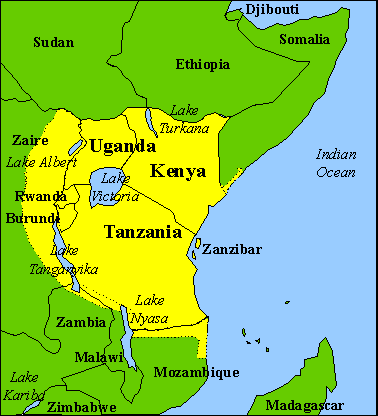

 Map Source: University of California.
According to purists, there are no more than two million Kiswahili speakers who live
essential along the along the east African coast of southern Somalia. They would be located in
Kenya, Tanzania, northern Mozambique, and on the off shore islands of Lamu, Zanzibar,
and Pemba. .Go here for more information.
It is the opinion of many scholars of Kiswahili that beyond the area described in this map, other Kiswahili
usage is nothing but pidginized versions, often derogatorily referred to as
Kingwana. One Zanzibar Homepage
states that the "Swahili is the most extensively spoken language in sub-Saharan Africa and is used in Tanzania,
Kenya, Uganda as well as certain parts of Zambia, Rwanda, Burundi, Malawi and Mozambique." Several socio-linguistic
would hardly warrant the exclusion of the Democratic Republic of the Congo. Such unfortunate
claims dismissing without good explanation ignore the hard fact that there are more Kiswahili speakers in
the Congo Kivu povince alone than in Rwanda and Burundi combined where its usage is rather limited and confined
to the capitals.
Map Source: University of California.
According to purists, there are no more than two million Kiswahili speakers who live
essential along the along the east African coast of southern Somalia. They would be located in
Kenya, Tanzania, northern Mozambique, and on the off shore islands of Lamu, Zanzibar,
and Pemba. .Go here for more information.
It is the opinion of many scholars of Kiswahili that beyond the area described in this map, other Kiswahili
usage is nothing but pidginized versions, often derogatorily referred to as
Kingwana. One Zanzibar Homepage
states that the "Swahili is the most extensively spoken language in sub-Saharan Africa and is used in Tanzania,
Kenya, Uganda as well as certain parts of Zambia, Rwanda, Burundi, Malawi and Mozambique." Several socio-linguistic
would hardly warrant the exclusion of the Democratic Republic of the Congo. Such unfortunate
claims dismissing without good explanation ignore the hard fact that there are more Kiswahili speakers in
the Congo Kivu povince alone than in Rwanda and Burundi combined where its usage is rather limited and confined
to the capitals.
As a user of that form and having studied it, it is only wrong to exclude it, but is actually part of the Kiswahili language. Although this form may be comprehended by many Sarufi speakers, the so-called most Kingwana users have a competent understanding of the Sarufi. Not only this version is studied in schools, but it is the form used in churches, in the written and spoken media and even in entertainment. The most common thing in the usage of Kiswahili in this area is the ability of such people living in a multilingual context to code-switch. It is therefore proper and even overdue that the map of Kiswahili be extended as far as the middle of the Democratic Republic of the Congo and to Northern Zambia where a sizeable number of exchange and migration has been taken place in the last fifty years.
